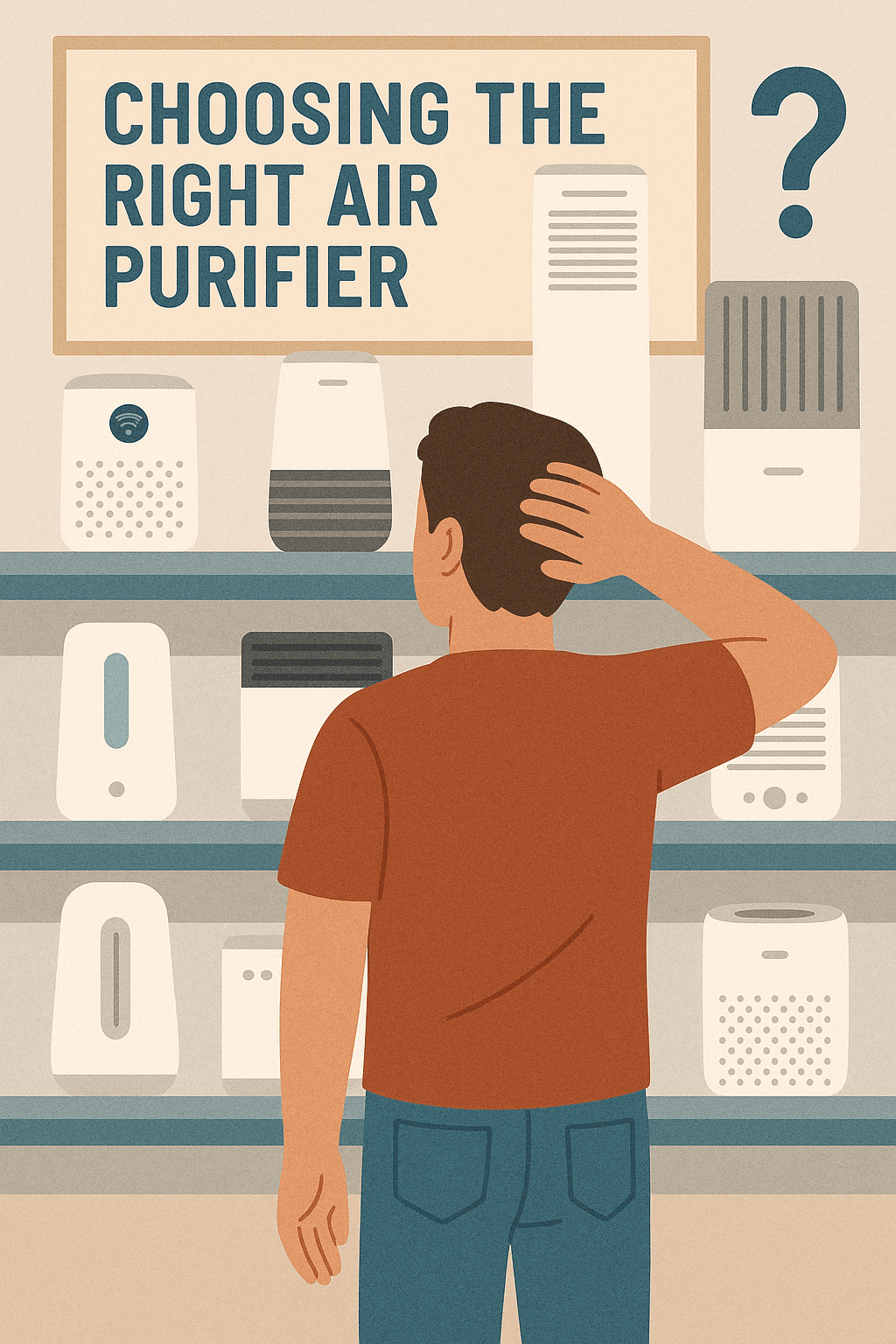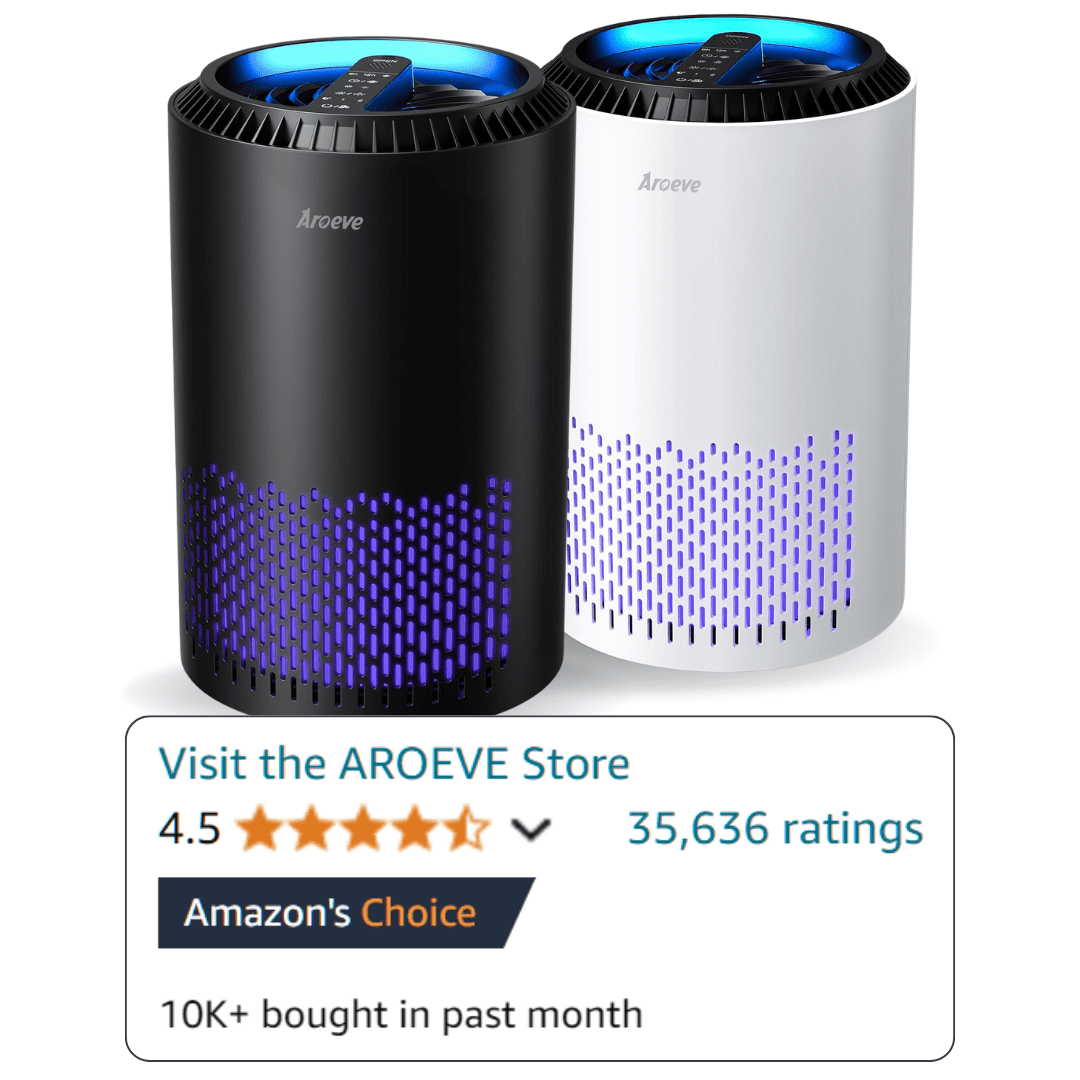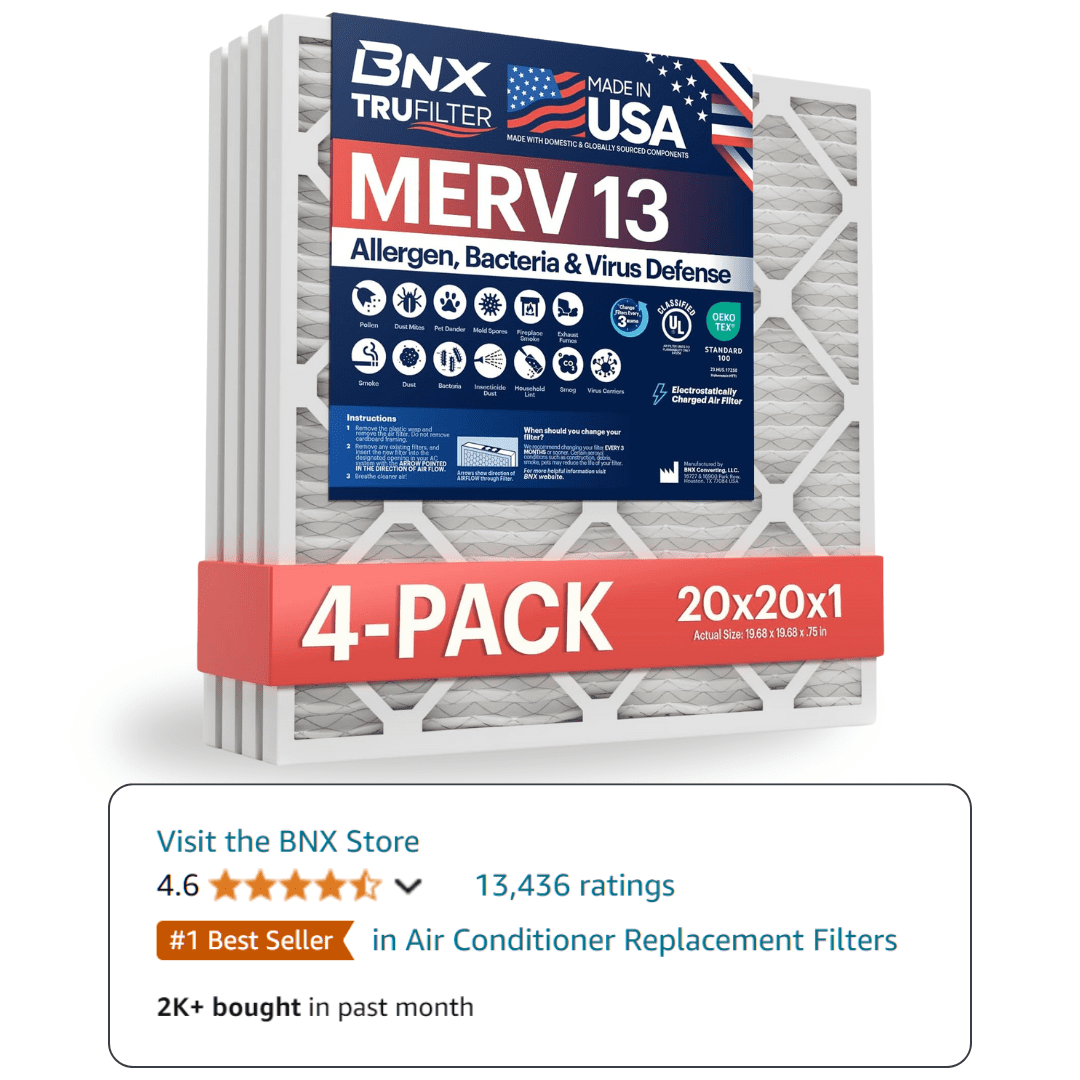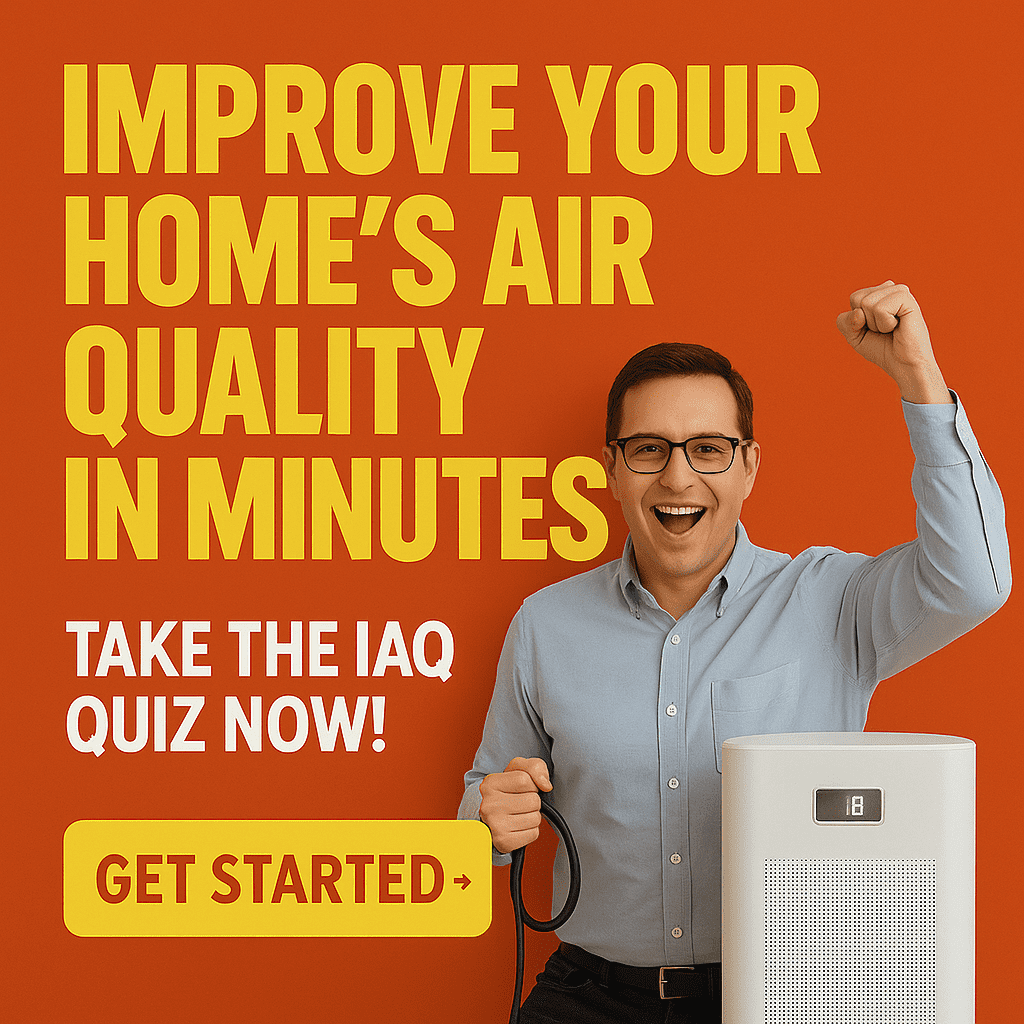Why Consider an Air Purifier?
We spend a significant amount of time indoors – at home, work, or school.
While we often worry about outdoor pollution, the air inside our buildings can sometimes be even more polluted. Poor indoor air quality (IAQ) can stem from various sources, including dust, pollen, pet dander, smoke, cooking fumes, cleaning products, mold spores, and volatile organic compounds (VOCs) off-gassing from furniture and building materials. You can learn more about these issues in our guide to common sources of indoor air pollution.
Poor IAQ isn’t just unpleasant; it can have real impacts on our well-being, contributing to allergies, asthma symptoms, headaches, fatigue, and potentially more severe long-term health effects. Read about the potential dangers in our article on the health effects of poor indoor air quality.
While the foundational steps to improving IAQ are always source control (removing or reducing the source of pollution) and ventilation (bringing in fresh outdoor air), these aren’t always sufficient or feasible. This is where air purifiers come in. An air purifier, also known as an air cleaner, is a device designed to remove pollutants from the air within a specific space.
Common reasons people invest in air purifiers include:
- Allergies: To capture airborne allergens like pollen, dust mites, and pet dander.
- Asthma: To reduce triggers like dust, dander, and mold spores.
- Wildfire Smoke: To filter out harmful fine particulate matter (PM2.5) and associated gases during smoke events.
- Pet Owners: To manage pet dander and odors.
- General Health Concerns: To reduce exposure to airborne particles and potential pathogens.
- Odor Control: To tackle persistent smells from cooking, pets, or smoke.
- VOC Reduction: To capture potentially harmful gases emitted from new furniture, paint, or cleaning supplies.
Managing Expectations: What Air Purifiers Can and Can’t Do
It’s crucial to have realistic expectations. Air purifiers excel at removing airborne pollutants that pass through their filters.
- What they CAN do: Filter out particles like dust, pollen, pet dander, mold spores, and smoke particles. Units with activated carbon can adsorb certain gases, odors, and VOCs. Some technologies aim to neutralize airborne microorganisms.
- What they generally CAN’T do: Remove pollutants that have already settled on surfaces (regular cleaning is still essential!). Eliminate the source of pollution. Capture all gases and VOCs (effectiveness varies greatly by type and amount of adsorbent). Guarantee 100% protection against illness (though they can reduce exposure to airborne pathogens). Effectively clean an entire house with a single, undersized unit.
Think of an air purifier as a valuable supplement to a broader strategy for maintaining healthy indoor air, which should always prioritize ventilation and controlling pollution sources first. Learn more about the fundamentals in our guide: What is Indoor Air Quality and Why Should You Care?
How Different Air Purifiers Work
Air purifiers employ various technologies to clean the air, each with strengths and weaknesses. Understanding these is key to choosing the right unit for your needs.
Mechanical Filtration (HEPA Filters)
- How it Works: This is the most common and generally recommended filtration method for particles. Air is forced through a fine, physical filter medium (typically made of fiberglass or specialized synthetic fibers) that traps airborne particles. The gold standard is the True HEPA filter.
- True HEPA Standard: Defined by the US Department of Energy, a True HEPA filter must capture at least 99.97 of airborne particles that are 0.3 micrometers (mum) in diameter. This particle size is notoriously difficult to trap and is used as the benchmark; HEPA filters are often even more efficient at capturing both larger and smaller particles through mechanisms like impaction, interception, and diffusion. Learn the specifics in HEPA Filters Explained: What They Are & How They Work.
- Pros: Highly effective at removing particulate matter including dust, pollen, pet dander, mold spores, bacteria, and smoke particles (PM2.5). No harmful byproducts generated by the filter itself. Widely available and proven technology.
- Cons: Does not remove gases, odors, or VOCs. Filters need periodic replacement (typically every 6-12 months, depending on usage and air quality), adding to running costs. Requires a fan, which consumes energy and produces noise.
Activated Carbon Filtration
- How it Works: This technology targets gases, odors, and VOCs through a process called adsorption (not absorption). Activated carbon is treated (often with heat or chemicals) to create a vast network of microscopic pores, vastly increasing its surface area. As air passes through the carbon filter, gas and odor molecules stick to these surfaces.
- Importance of Carbon Amount/Quality: The effectiveness depends heavily on the amount of activated carbon (more carbon = more surface area = longer lifespan and better capacity) and its quality (specific treatments can make it better at adsorbing certain chemicals). Thin carbon-impregnated pads are far less effective than filters containing several pounds of granular activated carbon. Dive deeper here: Activated Carbon Filters: How They Remove Odors & VOCs.
- Pros: Effective at removing many odors (cooking, pets, smoke), VOCs (from paint, furniture, cleaning products), and other gaseous pollutants. Can significantly improve the perceived freshness of indoor air.
- Cons: Does not effectively remove particulate matter (hence usually paired with a HEPA filter). Carbon becomes saturated over time and loses effectiveness, requiring replacement (frequency depends on pollutant levels and carbon amount). Not all gases/VOCs are adsorbed equally well.
UV-C Germicidal Irradiation
- How it Works: Utilizes ultraviolet light in the UV-C spectrum (typically around 254 nm wavelength) which has germicidal properties. The goal is to damage the DNA or RNA of microorganisms like bacteria, viruses, and mold spores as they pass through the purifier, rendering them unable to reproduce.
- Effectiveness Factors: Crucial factors are exposure time and intensity. Microorganisms need sufficient direct exposure to the UV-C light at adequate intensity to be neutralized. In many air purifiers, the airflow might be too fast for the UV light to be truly effective against all passing pathogens.
- Pros: Can potentially help neutralize some airborne microorganisms if implemented correctly (sufficient intensity and exposure time). Does not physically trap particles or gases.
- Cons: Questionable real-world effectiveness in many consumer-grade units due to short exposure times. Does absolutely nothing for particulate matter (dust, pollen, smoke) or gases/odors/VOCs. UV bulbs degrade over time and need replacement. Some UV lights (especially those producing wavelengths around 185 nm) can generate ozone, a lung irritant. Ensure any UV feature uses ozone-safe 254 nm lamps and consider it a secondary feature, not the primary purification method.
Ionizers (Negative Ion Generators)
- How it Works: Ionizers release negatively charged ions into the air. These ions attach to airborne particles (like dust, pollen, smoke). This charging causes the particles to clump together and become heavier, making them more likely to fall out of the air and settle onto surfaces (walls, floors, furniture) or potentially be captured more easily by a mechanical filter if one is present in the unit.
- Pros: Can help remove very small particles (ultrafine particles) from the air. Generally low energy consumption for the ionizing function itself (though the fan still uses power).
- Cons: The primary concern is the potential production of ozone as a byproduct. Ozone is a known lung irritant, and the EPA has warned about the health risks associated with ozone generators and devices that produce ozone, even at low levels (EPA – Ozone Generators that are Sold as Air Cleaners). While some modern ionizers claim low or no ozone production, caution is warranted, especially for individuals with respiratory issues. Look for certifications like CARB (California Air Resources Board) compliance. Additionally, the particles removed from the air settle onto room surfaces, requiring more frequent cleaning to prevent resuspension.
Ozone Generators
- Strong Warning: Devices intentionally designed to produce significant amounts of ozone are generally not recommended or considered safe for use in occupied spaces. Ozone is effective at reacting with certain chemicals and microorganisms, but it is a toxic gas and a powerful lung irritant. The EPA states that ozone concentrations high enough to be effective against pollutants exceed public health standards (EPA – Ozone and Indoor Air Quality). While sometimes used professionally for shock treatment in unoccupied spaces (e.g., fire restoration), they should never be run when people or pets are present. Do not confuse these with ionizers or other air purifier types, although some other types can produce ozone as an unwanted byproduct.
Photocatalytic Oxidation (PCO) / PECO
- How it Works: PCO typically uses UV light (often UV-A) directed onto a catalyst (usually titanium dioxide, TiO_2). This reaction creates highly reactive hydroxyl radicals (cdotOH) that theoretically break down gaseous pollutants like VOCs and odors into simpler molecules like carbon dioxide (CO_2) and water (H_2O). PECO (Photo-Electrochemical Oxidation) is a proprietary variation of this concept.
- Pros: Potential to break down certain VOCs and odors rather than just trapping them. May neutralize some microorganisms that come into contact with the catalyst surface.
- Cons: Newer technology compared to HEPA/Carbon. Effectiveness can vary significantly based on design, catalyst quality, humidity, and the specific pollutants present. A major concern is the potential for incomplete oxidation, which could create new, potentially harmful byproducts (like formaldehyde or acetaldehyde). Research on real-world effectiveness and safety is ongoing. Like UV-C, does little for particulate matter on its own.
Combination Units
- Most Common Approach: Recognizing that no single technology handles all types of pollutants effectively, most reputable air purifiers on the market are combination units. A typical setup includes:
- Pre-filter: Captures larger particles like hair and lint, extending the life of the main filters. Often washable or vacuumable.True HEPA Filter: Captures fine particulate matter.Activated Carbon Filter: Adsorbs gases, odors, and VOCs.
- Some units may add optional features like ionizers or UV-C lamps, but the core performance relies on the mechanical (HEPA) and adsorbent (Carbon) filters. This multi-stage approach provides the most comprehensive air cleaning for typical home environments.
- Pre-filter: Captures larger particles like hair and lint, extending the life of the main filters. Often washable or vacuumable.True HEPA Filter: Captures fine particulate matter.Activated Carbon Filter: Adsorbs gases, odors, and VOCs.
Key Performance Metrics You MUST Understand
To compare air purifiers objectively and choose one that fits your room size and needs, you need to understand these key metrics:
CADR (Clean Air Delivery Rate)
- What it Measures: CADR is the most important industry standard metric for comparing the performance of air purifiers on particulate matter. Developed by the Association of Home Appliance Manufacturers (AHAM), it measures the volume of filtered air delivered by an air purifier per minute. It’s typically reported for three common particle types: Smoke, Dust, and Pollen, expressed in cubic feet per minute (CFM). A higher CADR number indicates faster air cleaning for that specific pollutant.
- How to Use it for Room Size: AHAM recommends a general guideline called the “2/3 Rule”. The Smoke CADR rating of the purifier should be at least two-thirds of the room’s area in square feet. For example, for a 15ft x 20ft room (300 sq ft), you’d want an air purifier with a Smoke CADR of at least (2/3) * 300 = 200 CFM. This assumes a standard 8-foot ceiling height and aims for roughly 4.8 air changes per hour (see ACH below). Look for the AHAM Verifide mark on packaging, which indicates the CADR has been independently tested. (AHAM Verifide Air Cleaners).
ACH (Air Changes Per Hour)
- What it Means: ACH indicates how many times the entire volume of air in a room is theoretically filtered by the purifier in one hour. It’s a crucial indicator of how thoroughly and frequently the air is being cleaned. Learn more about ACH (Air Changes per Hour) Explained.
- Recommended ACH:
- General Use: 2-3 ACH provides a baseline level of air cleaning.
- Allergies, Asthma, Smoke: 4-5+ ACH is recommended to keep pollutant levels lower more consistently. Higher ACH means faster removal of contaminants as they are introduced.
- How it Relates to CADR and Room Size: You can calculate ACH using the CADR (use Smoke CADR for a general estimate) and the room’s volume: ACH=fracCADR(inCFM)times60textminutes/hourtextRoomVolume(incubicfeet) (Room Volume = Length x Width x Ceiling Height) Using the previous example (300 sq ft room, 8 ft ceiling = 2400 cubic feet) and a CADR of 200 CFM: ACH=frac200times602400=frac120002400=5 ACH. This aligns with the AHAM recommendation for effective cleaning.
Filter Ratings (MERV / HEPA)
- HEPA Standard: As discussed earlier, True HEPA (99.97 capture at 0.3mum) is the key standard for particle filtration efficiency in portable air purifiers. Beware of terms like “HEPA-like” or “HEPA-type,” which often don’t meet this rigorous standard.
- MERV (Minimum Efficiency Reporting Value): This rating system (1-16, sometimes higher) is primarily used for HVAC filters in central heating and air conditioning systems. While not directly applied to portable air purifier filters in the same way, it illustrates the concept of particle capture efficiency. A higher MERV rating means better filtration of smaller particles. A typical residential HVAC filter might be MERV 8-11, while True HEPA performance is roughly equivalent to MERV 17 or higher. Read more about Understanding MERV Ratings: Choosing the Right HVAC Filter.
H3: Noise Levels (Decibels, dB)
- Why it Matters: Air purifiers use fans, which create noise. Since you’ll likely run the unit for extended periods, especially in bedrooms or offices, noise level is a critical consideration. Noise is measured in decibels (dB).
- Comparisons:
- 20-30 dB: Whisper, rustling leaves (ideal for sleeping)
- 40 dB: Library quiet
- 50 dB: Moderate rainfall, refrigerator hum (noticeable but often acceptable)
- 60 dB: Normal conversation (can be disruptive)
- 70+ dB: Vacuum cleaner (loud)
- Consideration: Most manufacturers list dB levels for the lowest and highest fan speeds. Look for units that are quiet enough for your comfort on the speed setting you anticipate using most often. “Quiet air purifier” is a common search term for a reason!
H3: Energy Consumption (Energy Star)
- Impact: An air purifier running 24/7 can contribute to your electricity bill.
- Energy Star Certification: Look for the Energy Star label. Energy Star certified air purifiers are, on average, about 25% more energy-efficient than standard models, saving you money and reducing your environmental impact (Energy Star – Certified Air Purifiers).
Choosing the Right Air Purifier: A Step-by-Step Guide
Step 1: Identify Your Primary Concern
What is the main reason you need an air purifier?
- Allergies/Asthma: Focus on high-efficiency particle filtration (HEPA).
- Wildfire Smoke/General Smoke: Need excellent particle filtration (HEPA for PM2.5) AND substantial activated carbon for gases and odors.
- Pet Owners: HEPA for dander, plus activated carbon for odors.
- VOCs/Chemicals/Odors: Prioritize a unit with a large amount of high-quality activated carbon. HEPA is still beneficial for associated particles.
- General Dust/Air Quality Improvement: A balanced HEPA + Carbon combination unit is usually best.
- Mold Concerns: HEPA is essential for capturing airborne mold spores. Address the moisture source first! (See specific section below).
Step 2: Determine Your Room Size
Measure the square footage (Length x Width) of the room where you plan to use the air purifier most. If you plan to move it between rooms, size it for the largest room.
Step 3: Calculate Required CADR/ACH
Use the AHAM 2/3 rule based on your room’s square footage to find the minimum recommended Smoke CADR.
- Minimum Smoke CADR = Room Area (sq ft) x (2/3)
- If high ACH is desired (allergies, smoke), consider selecting a unit with an even higher CADR than the minimum calculated, effectively “oversizing” it for the room. This allows you to run it on lower, quieter settings while still achieving excellent air cleaning. Calculate the expected ACH using the formula above if ceiling height is known.
Step 4: Select Appropriate Filter Technology
Based on your primary concern (Step 1) and understanding of the technologies:
- Particles (Dust, Pollen, Dander, Smoke PM2.5, Mold Spores): True HEPA is essential.
- Gases, Odors, VOCs, Smoke Gases: Activated Carbon is necessary. The amount matters – look for units with pounds of carbon, not just thin filters, for serious gas/odor issues.
- Microorganisms: While HEPA traps bacteria and mold spores, if germicidal action is a secondary priority, consider units with well-implemented, ozone-safe UV-C, but don’t rely on it as the primary method.
- Avoid: Ozone generators for occupied spaces. Be cautious with ionizers due to potential ozone risks unless they are CARB certified. PCO/PECO technology is still evolving.
- Most Cases: A combination unit with Pre-filter + True HEPA + Activated Carbon offers the best all-around performance.
Step 5: Consider Features & Long-Term Costs
- Filter Replacement: Check the cost and recommended replacement frequency for all filters (HEPA, Carbon, Pre-filters if not washable). This is a significant ongoing expense.
- Noise Levels: As discussed, check dB ratings, especially for lower fan speeds if using in quiet areas.
- Energy Consumption: Look for Energy Star certification. Estimate annual running costs based on wattage and electricity rates.
- Automatic Mode & Air Quality Sensors: Some units have sensors (particle, sometimes VOC) that automatically adjust fan speed based on detected air quality. Convenient, but sensor accuracy can vary.
- Smart Features: Wi-Fi connectivity, app control, scheduling, filter life monitoring. Nice-to-haves, but not essential for core function.
- Size and Aesthetics: Consider the unit’s physical footprint and design.
Step 6: Check for Certifications
- AHAM Verifide: Independently verifies CADR ratings for smoke, dust, and pollen. Essential for performance comparison.
- Energy Star: Indicates better energy efficiency.
- CARB Certification: The California Air Resources Board certifies air cleaners that meet strict ozone emission limits (below 50 parts per billion). This is crucial, especially if considering a unit with an ionizer, and is legally required for sale in California. (CARB – California Certified Air Cleaning Devices). Look for this certification regardless of your location if ozone is a concern.
- ETL/UL Listed: Basic electrical safety certifications.
Air Purifiers for Specific Needs
Best Technologies for Allergies & Asthma
- Primary Need: Removal of airborne particulate allergens (pollen, dust mite debris, pet dander, mold spores).
- Key Technology: High-quality True HEPA filtration is paramount. Look for tightly sealed units to prevent air bypass around the filter.
- Secondary: Activated carbon can help with odor triggers if present. Aim for higher ACH (4-5+) to keep allergen levels consistently low. Consider our guide on Managing Allergies & Asthma by Improving Indoor Air Quality.
Best Technologies for Wildfire Smoke & PM2.5
- Primary Need: Removal of fine particulate matter (PM2.5) and harmful gases/VOCs present in smoke.
- Key Technologies:
- True HEPA: Essential for capturing the dangerous PM2.5 particles.
- Substantial Activated Carbon: Critical for adsorbing the volatile organic compounds, nitrogen oxides, and odors associated with smoke. Look for units with several pounds of carbon, not just a light coating.
- Strategy: Run continuously during smoke events. Aim for high ACH (5+). Ensure windows and doors are closed.
Best Technologies for Pet Owners
- Primary Need: Removal of pet dander (allergens) and pet odors.
- Key Technologies:
- True HEPA: Captures airborne pet dander effectively.
- Activated Carbon: Addresses associated pet odors.
- Maintenance: A washable pre-filter is highly beneficial for capturing larger pet hair, extending the life of the HEPA and Carbon filters. Regular cleaning of the unit and surroundings is still vital.
Best Technologies for Mold Spores
- Primary Need: Capturing airborne mold spores to reduce inhalation and potential spread.
- Key Technology: True HEPA filtration effectively traps mold spores, which typically range from 3-40 micrometers.
- Crucial Caveat: An air purifier does not solve a mold problem. It only captures airborne spores. You MUST identify and fix the underlying moisture issue that allowed mold to grow in the first place. Thorough remediation by qualified professionals may be necessary.
- Resources:
Best Technologies for VOCs & Odors
- Primary Need: Removal of gaseous pollutants like formaldehyde, benzene, cleaning chemical fumes, cooking odors, etc.
- Key Technology: Substantial Activated Carbon filtration is the most effective approach. The more carbon, the better the adsorption capacity and lifespan. Some specialized carbon blends may target specific chemicals more effectively.
- Consideration: HEPA is still useful as many sources of VOCs/odors (e.g., cooking, smoke) also produce particles.
Getting the Most Out of Your Air Purifier: Placement & Maintenance
Buying the right unit is only half the battle; proper use is key to effectiveness.
- Optimal Placement:
- Place the unit in the room where you spend the most time or where the primary pollution concern exists (e.g., bedroom for sleep quality, living room during wildfire smoke).
- Position it away from walls and furniture to allow for unobstructed airflow in and out of the unit. Avoid placing it in corners or under curtains.
- Elevating slightly off the floor can sometimes improve circulation, but follow manufacturer guidance.
- Importance of Regular Filter Replacement: This is NON-NEGOTIABLE for sustained performance.
- HEPA & Carbon Filters: Replace according to the manufacturer’s recommendations (typically 6-12 months for HEPA, 3-6 months for Carbon, but varies greatly) or sooner if performance degrades (reduced airflow, persistent odors). Many units have filter life indicators.
- Pre-filters: Clean washable pre-filters regularly (e.g., monthly) as per instructions. Replace non-washable pre-filters as needed. Clogged filters drastically reduce efficiency and airflow.
- Cleaning the Unit: Wipe down the exterior and air intake/outlet grills periodically to prevent dust buildup. Ensure the unit is unplugged before cleaning.
- Run it Consistently: Air quality changes constantly. For best results, run your air purifier continuously, especially during high pollution periods (allergy season, smoke events) or when sources are active (cooking, cleaning). Running it on a lower, quieter setting 24/7 is often more effective than running it on high for short bursts.
Common Air Purifier Myths Debunked
Misinformation abounds. Let’s clear up some common myths:
- Myth: “Ionizers are completely safe and just make the air fresher.”
- Reality: Ionizers can produce harmful ozone, a lung irritant. While some may produce very little, the risk exists, especially for sensitive individuals. Always look for CARB certification and prioritize HEPA/Carbon filtration. “Freshness” is subjective; true cleaning removes pollutants. EPA – Ozone Generators Sold as Air Cleaners
- Myth: “UV light kills everything instantly.”
- Reality: UV-C requires sufficient exposure time and intensity to deactivate microorganisms. In the fast airflow of many purifiers, its real-world effectiveness can be limited. It does nothing for particles or gases.
- Myth: “You never need to replace the filters” or “Permanent filters last forever.”
- Reality: Filters trap pollutants and inevitably become clogged or saturated. HEPA filters lose airflow, and Carbon filters stop adsorbing. “Permanent” filters usually refer to washable pre-filters or sometimes cleanable collector plates in electrostatic precipitators (a less common tech not detailed here, which also carries ozone risks). HEPA and Carbon filters always require periodic replacement for effective operation.
- Myth: “One small air purifier can cover my whole house.”
- Reality: Air purifiers are rated for specific room sizes (based on CADR). A single unit, unless extremely powerful and centrally located in an open-plan layout (which is rare), cannot effectively clean the air in multiple separate rooms or an entire home. You typically need appropriately sized units for the specific rooms where clean air is desired.
- Myth: “Air purifiers eliminate the need for cleaning.”
- Reality: Air purifiers capture airborne pollutants. Dust, allergens, and other particles still settle on surfaces.92 Regular dusting, vacuuming, and cleaning remain essential for good IAQ.
Investing in Cleaner Indoor Air
Choosing an air purifier is an investment in a healthier indoor environment. By understanding the different technologies (HEPA for particles, Activated Carbon for gases/odors), key performance metrics (CADR, ACH), and your specific needs and room size, you can make an informed decision.
Remember the key factors:
- Identify your primary air quality concern.
- Choose the right filter technology (HEPA + Carbon is often best).
- Select a unit appropriately sized for your room (Check CADR & calculate ACH).
- Look for essential certifications (AHAM Verifide, CARB, Energy Star).
- Factor in long-term costs (filter replacements, energy).
- Use and maintain it properly (placement, filter changes, consistent operation).
An air purifier is a powerful tool, but it works best as part of a comprehensive indoor air quality strategy that includes minimizing pollution sources and ensuring adequate ventilation. By taking these steps, you can breathe easier and create a healthier space for yourself and your family.




